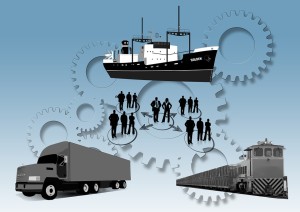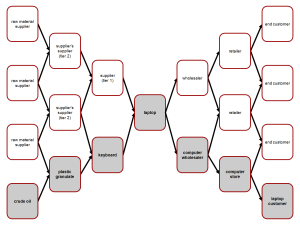 The field of logistics has been around for quite a while, but it has been evolving at a rapid rate due to the integration of technology. Students who are interested in having a career in logistics can feel overwhelmed at the amount of lingo that is used in this field, which is why we have cultivated some of the most commonly used industry jargon.
The field of logistics has been around for quite a while, but it has been evolving at a rapid rate due to the integration of technology. Students who are interested in having a career in logistics can feel overwhelmed at the amount of lingo that is used in this field, which is why we have cultivated some of the most commonly used industry jargon.
The list below will help you get your feet wet, and have a better concept of what is important in the logistics world. To make this easier to navigate, we’ve organized these words under two categories, “Business” and “Shipment.”
Business
The words listed below all apply to the operational end of logistics that does not deal with sending or receiving products.
- Agent – This is a person who represents a business when negotiating a contract, who is allowed to make most if not all of the decisions on behalf of the business they are employed with.
- Benchmarking – Is the way for a business to assess their policies, strategies, programs, etc. in comparison to their competitors. There are two types of benchmarking:
- Internal Benchmarking: This refers to evaluating the business itself, and determining what is realistic for your company. In relation to logistics, this may involve deciding how much of a shipment truck you would like to utilize compared to what is most cost effective for your company.
- External Benchmarking: This refers to looking at your competitors, evaluating areas in which they may be stronger than your company, and then looking at your internal benchmarking to determine how you can either match or exceed your competitor’s performance.
- Blanket Purchase Agreement (BPA) – This is essentially a contract between a buyer and seller for purchasing goods in large quantities with the goal to cut future costs. There is typically wiggle room in the contract to be able to negotiate for discounts if needed in the future.
- Escrow – A third party that holds funds and/or documents until services or goods have been completed as agreed to by two other parties (a buyer and a seller). An escrow is opened with a third party in order to protect the interests and liabilities of the buyer and seller.
- Inventory Management Software – This one is fairly straightforward, it a software that manages how much inventory you have so that you can see which items you need to order more of. This can also be used to create other production-related documents, and helps prevent companies from both running out of a product and overstocking.
- Metrics – Also referred to as Performance Metrics, this a quantifiable measure of how efficiently your company is running. In terms of logistics, metrics are often run to evaluate the successes and areas of improvement regarding your supply chain. Performance metrics are used when a business is measuring benchmark processes.
- Procurement – It is essentially a fancy, and slightly more in-depth word for “purchasing.” Procurement includes buying the product, and it also refers to locating the product/services beforehand, negotiating prices, and the documentation required once the transaction is complete.
- Reverse Logistics – Some refer to this as Aftermarket Logistics, Retrogistics, or Aftermarket Supply Chain, and it is a slightly complicated term. You may find that it is defined in a myriad of ways, but it is essential when a company reuses any product or materials in order to save on costs. This includes reusing shipping containers and packing materials.
 Supply Chain – This refers to the process from procurement to customer purchase and everything in between. Anything that is related to moving the product or service is part of the supply chain. By clicking on the picture, you can see an example of a supply chain when the product is a laptop.
Supply Chain – This refers to the process from procurement to customer purchase and everything in between. Anything that is related to moving the product or service is part of the supply chain. By clicking on the picture, you can see an example of a supply chain when the product is a laptop.
[blank_space height=’1em’]
[blank_space height=’1em’]
[blank_space height=’1em’]
[blank_space height=’1em’]
[blank_space height=’1em’]
[blank_space height=’1em’]
[blank_space height=’1em’]
Shipment
When dealing with the shipping and receiving of products, you will want to be familiar with these commonly used terms.
- Carrier – This is a person or company who moves products from one place to another.
- Cash On Delivery (COD) – COD is when the product is paid for once it has been delivered, rather than through a contract set up prior to delivery.
- Consign – This means to deliver a product in order for it to be sold. A consigner is the seller who sends the product, and the consignee refers to the buyer who is receiving the product.
- Distribution Center (DC) – This is a facility that typically is smaller than a warehouse and is used for temporary storage upon receiving or shipping out smaller quantities of goods.
- Gross Vehicle Weight (GVW) – This is the weight of the vehicle (includes land, water, and air transportation) plus the weight of the cargo that it is carrying. This is important to consider when working in logistics as it does affect the overall cost of shipping.
- Just In Time (JIT) – This is a way to streamline your supply chain so that the product arrives precisely the moment you need it. JIT allows you to save money because if a product arrives too early, then it is taking up valuable space in your warehouse, preventing you from being able to order other products that you may need to. If the product arrives late, it throws off and is late throughout the rest of supply chain.
- Truckload – This refers to the amount of products you will need and how much space they take up in transit. There are two types of truckloads:
- Full Truckload (FTL): You guessed it, this means the product that you need to ship or receive will take up an entire truck. Truck, in this case, is referring to a semi-truck (semi-trailer).
- Less-Than-Truckload (LTL): Right again! This means that the amount of product you would like to send/receive does not require a semi-truck. These two terms are essentially no-brainers, and are included in this list so that you become familiar with their acronyms (FTL and LTL), since they are rarely spelled out.
- Raw Materials – Also known as unprocessed material, this term refers to the supplies that are needed in order to create your product.
- Stream – This is where you product in going in the supply chain. Upstream refers to the process of finding and taking of raw materials from their natural state to the processing plant, but does not include any of the actual processing. Downstream refers to the actual processing of your raw materials that you took during the “upstream” stage. Downstream basically includes the creation of the product and its final sale to the buyer.
- Transportation Management System (TMS) – This is a logistic software that allows you to manage the transportation portion of your supply chain. Depending on the software, you can analyze your costs by converting your shipping data into readable charts and graphs, and allows you to plan the best route for your shipment.
[blank_space height=’1em’]
[blank_space height=’1em’]
[blank_space height=’1em’]
[blank_space height=’1em’]
[blank_space height=’1em’]
[blank_space height=’1em’]
[blank_space height=’1em’]
[blank_space height=’1em’]
This logistics lingo list is just the beginning of all that there is to learn in this field. You can kick-start your education now that you know the basic terminology that is used widely throughout this industry!
